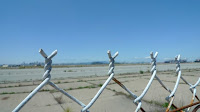Puccini's "
La Fanciulla del West" is not one of the main-stream operas. I have never seen it before (but auditioned for Wowkle, the Indian maid, once, ugh). The setting is in the Sierra Nevada Foothills, during the gold rush. The protagonist is Minnie, the owner of the local saloon, and only woman the miners have contact with. She acts as a surrogate mother and object of desire. Especially the sheriff is lusting after her, but she won't let any man come close, until Johnson shows up, the local bandit planning to rob the place. Through love, Johnson gives up his thiefdom, Minnie rescues him from the noose, and they live happily ever after.
There are a few issues with this opera that probably make it less popular than most of the other Puccini operas:
- The awkward setting in the Sierra foothills, during the gold rush (who would want to hear about the gold rush in Italian?)
- The lack of memorable arias
- The need for first class singers
San Francisco Opera's production had a lot of potential. The closeness in location (everybody here know the Sierra foothills and the history of the gold rush), a first class opera company, great staging, world class singers. Unfortunately, while mostly entertaining, this production didn't quite live up to its potential.
Several of the charactors' names were familiar names from the area. The
Wells Fargo agent, Ashby, was reminicent of one of the first settlers of Berkeley,
William Ashby, now mostly familiar through Ashby Avenue, a major street in Berkeley. Wells Fargo (the present day bank) should have financed the whole production, considering that "their" agent played a good sized part. A miner's name,
Sonora, most certainly came from the city of Sonora, a gold rush town on
Route 49 (see picture on the right), a very busy town that we visited last on our trip to
Knights Ferry.
The orchestra, under the baton of
Luisotti, sounded great, wonderful sound, very musical. But this is opera, and overpowering the singers, so much that several times, I didn't realize somebody was singing, doesn't do justice to the music, no matter how beautiful.
I have seen
Deborah Voigt in many productions, mostly at the Met. She always impressed me with her soaring, beautiful voice, and her wonderful portrayal of the characters. I don't think, Minnie is the best role for her. Her portrayal was quite wonderful, she was a very convincing Minnie, but the beauty of her voice was hidden in the many "conversational", recit-like parts of her role. She was shining in the upper middle part of her voice during long legato lines, too bad there weren't more of those.
I saw
Salvatore Licitra years ago, when he was flown in from Italy to take over what was supposed to be Pavarotti's final Tosca at the Met. He was promising at the time, and yesterday, he showed that he has developed into a solid performer, interesting voice, interesting characterization. However, he unfortunately hasn't figured out yet, how to connect the high notes to the rest of the voice.
Maya Lahyani, a new Adler fellow, sounded very beautiful as Wowkle, I am sure we'll hear more from her in the future. The other men were good, but again, the orchestra drowned them out at times.
The staging was mostly entertaining. Minnie riding in on a horse lost a little bit of its impact by the two guides making sure the (very sweet) horse doesn't run into the pit. But this was the second opera in a row with animals on stage (after the dogs in Walküre), and with real fire (here a campfire). What are we going to see in Faust next week?
 Kkrishnaa, the protagonist, is a screen-writer for an Indian soap, and observes the inhabitants of a neighboring luxury apartment building with a telescope to find ideas for her soap (she suffers from writers block). The most bizarre things happen over there, but apparently not bizzare enough, because Kkrishnaa decides to stirr the pot and add a little pseudo-blackmail. After she witnessed a murder, her life is in danger. Incidentally, most people who live in the building are connected to the murdered woman. The police is very forthcoming to share their findings with K. and eventually, she solves the murder. Kkrishnaa is a witty, ruthless, not very likable but amusing person mostly interested in advancing her career, and surrounded by career-related intrigue. Plenty of examples of her screen-writing are given in the book, with insight into the values these soaps want to convey and the way Indian TV is written ("faints, repeat three times from different angles in slow motion"...). Interesting and fast paced, quite over the top exaggerations (I hope) of modern Indian life.
Kkrishnaa, the protagonist, is a screen-writer for an Indian soap, and observes the inhabitants of a neighboring luxury apartment building with a telescope to find ideas for her soap (she suffers from writers block). The most bizarre things happen over there, but apparently not bizzare enough, because Kkrishnaa decides to stirr the pot and add a little pseudo-blackmail. After she witnessed a murder, her life is in danger. Incidentally, most people who live in the building are connected to the murdered woman. The police is very forthcoming to share their findings with K. and eventually, she solves the murder. Kkrishnaa is a witty, ruthless, not very likable but amusing person mostly interested in advancing her career, and surrounded by career-related intrigue. Plenty of examples of her screen-writing are given in the book, with insight into the values these soaps want to convey and the way Indian TV is written ("faints, repeat three times from different angles in slow motion"...). Interesting and fast paced, quite over the top exaggerations (I hope) of modern Indian life.



















































